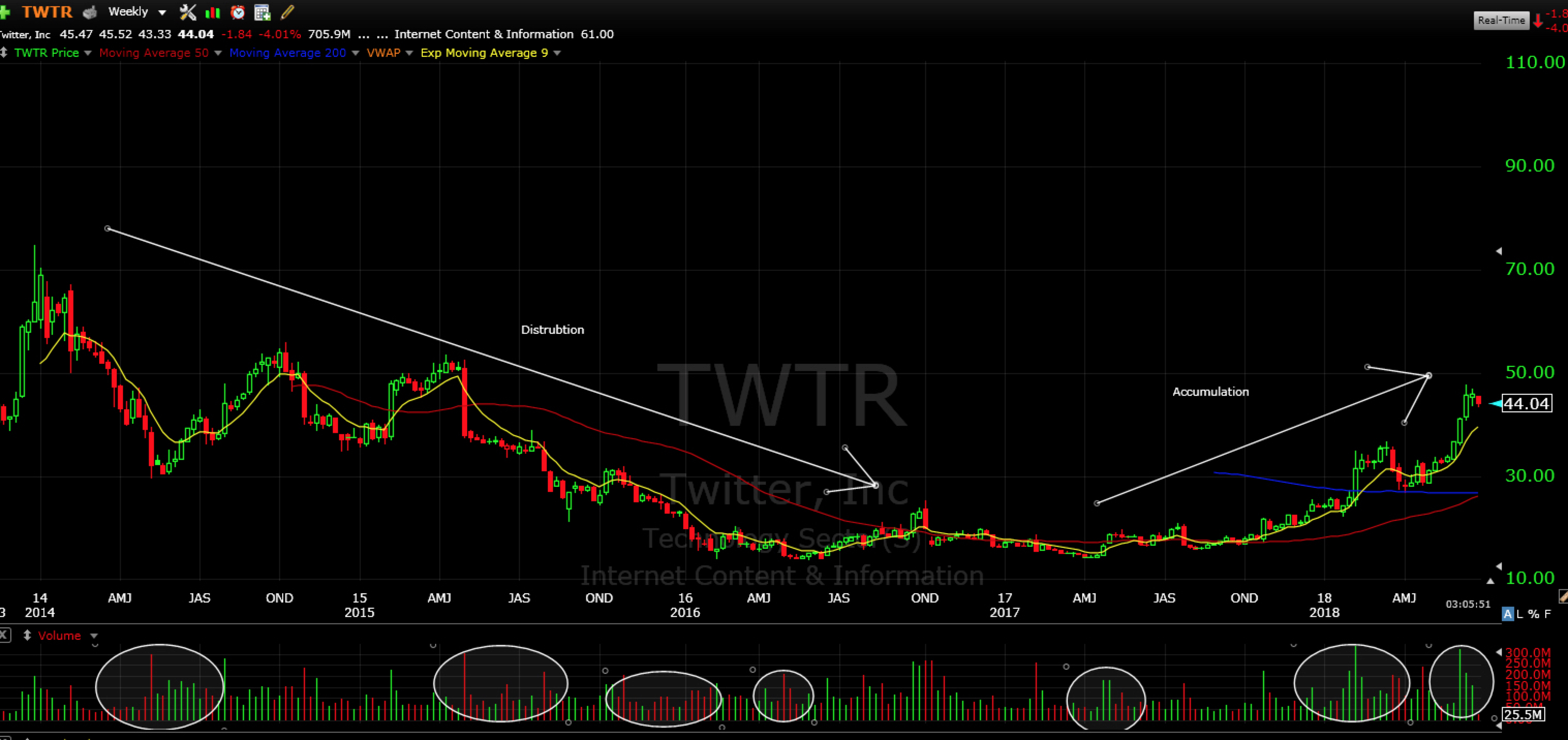
Stocks are either in a period of consolidation or trending. As short-term traders, we want to focus on the periods where stocks are trending in an obvious direction. We enter momentum stocks in trends and stay in them as long as they are moving in the direction of the trend. In this article, we will be learning the four stages and cycles that stocks enter. By learning how to recognize these different stages, we become more profitable traders because we know when to apply a particular style of trading.
Accumulation
An accumulation period is a span of time in which individual traders and institutions are amassing shares of a stock. This period has no clear trend and is characterized by a period of sideways price action that may precede a price increase. On a chart, this is what we call a “basing” period. This period begins after the completion of a downtrend where the sellers have started to let up and shorts have started to realize their profits.
During this period there is a contraction of the price range and no real edge for day traders. It’s difficult to time when the accumulation period will end, but once a key level of resistance is broken and you start to see higher lows, the accumulation stage is over and we are into the run-up period.
Run-Up
The run-up period is the best time for momentum traders. Once a stock comes out of the accumulation phase, a whole fresh set of buyers come in (traders like us). We are all essentially going after a limited amount of shares, as the stock has little supply as it just came off of a long period of basing. This is when the moving averages start to slope and price breaks out, putting buyers firmly in control of the stock.
The stock at the start of the run-up phase will have high relative to its’ volume in the accumulation phase. You will see great volume patterns on any price thrusts followed by low volume consolidations or pullbacks. As long as the pullbacks are of relatively low volume in the upper part of its range, the trend can continue without tiring.
The end of the run-up phase is often characterized by increased volatility, and even higher relative volume when the stock starts to fail to make news highs and traders all run for the doors at the same time, resulting in very sharp sell-offs. The pullbacks near long-term and large support levels, i.e. moving averages, will still be bought, but when the bounces start to fail or become light a change in environment is at hand, meaning its time to tighten your risk and watch for a potential reversal.
Distribution
The distribution period is similar to the accumulation period in that there is no clear price trend and sideways price action. Unlike the accumulation period, this period is defined by the distribution of shares, with savvy traders and larger institutions reducing or eliminating their holdings. This period comes at the end of a run-up, as demand for shares no longer exceeds supply and the price goes sideways. The dips in the stock become sharper and bounces fade quickly as fresh supply is constantly coming into the market. A distribution period can be a low-volume, low volatility period the ends up being range-bound as neither bulls or bears can gain control. But there are small signs of supply beginning to exceed demand of the stock.
Check out the chart below for an example of the distribution and accumulation phases:
Run-Down
Once the supply of shares exceeds the demand, the distribution period ends and the run-down begins. This period is the inverse of the run-up, with a defined downward trend to the price of the security. This is not a favorable period for most traders. The news cycle is very negative, and longs are trapped. There are big bag holders in almost all stocks, and traders who try to catch the falling knives blow up.
This stage is characterized by lower lows and lower highs. Short sellers and sellers offer tremendous amounts of supply and there is a huge absence of buyers, causing pressure in the markets. During this time, fundamentals, news, everything is thrown out the window as only fear guides the market. Logic does not rule this period and stocks go much lower than everyone imagines. Often climatic selling and the bulls giving up total hope coincide with the end of the run-down. If the market starts to see a period of higher lows it may enter the accumulation phase. If we see higher highs and higher lows we might have a full on reversal and skip the accumulation phase.
Sign Up For The Free 4-Day Live Course
If you missed our last post of the Bulls Elite Series about stock charting basics, you can check it out here. We will go in more depth about how to profit in each market cycle in our free 4 day live course on July 22nd.
Reserve your seat for the free 4-day live course here.
PS if you’re coming let us know on Facebook and share this event with your friends. Click here to join our Facebook event.



